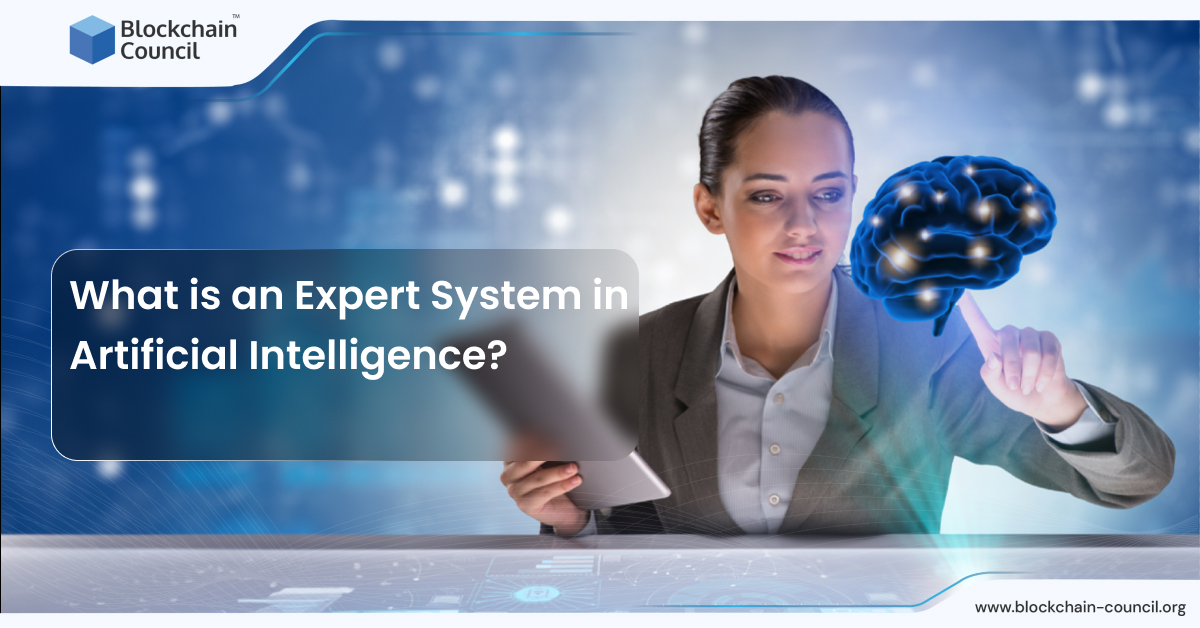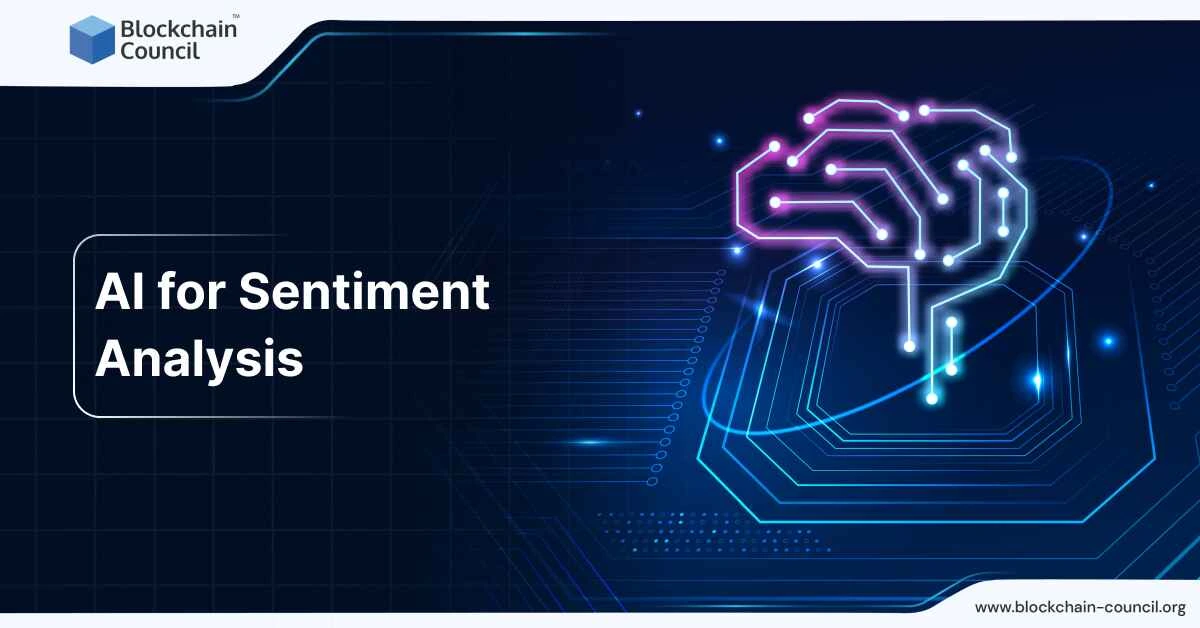
- Blockchain Council
- September 13, 2024
Summary
- Expert systems in artificial intelligence emulate human decision-making using rule-based reasoning and knowledge integration.
- The origins of expert systems date back to the 1960s, with pioneers like Edward Feigenbaum leading their development for complex problem-solving in areas like medicine and engineering.
- Modern expert systems integrate machine learning, data mining, and flexible approaches to enhance their performance and adaptability.
- Components of expert systems include the knowledge base, inference engine, user interface, and an explanation module for transparency.
- The working mechanism involves the knowledge base storing facts and rules, the inference engine applying logical rules, and the user interface facilitating interaction.
- Expert systems development involves identification, conceptualization, formalization, implementation, testing, and ongoing maintenance stages.
- Applications of expert systems span healthcare, finance, telecommunications, agriculture, customer service, transportation, law, design, and manufacturing.
- Examples of expert systems include MYCIN for bacterial infections, DENDRAL for chemical analysis, PXDES for lung cancer detection, and CaDet for early cancer detection.
- Advantages of expert systems include high precision, cost-effectiveness, consistency, and speed, while limitations include linear thinking, lack of intuition, and challenges in extraordinary situations.
- Future trends in expert systems include integration with other AI technologies, increased automation and efficiency, focus on ethical AI, enhanced user experience, market expansion, and collaboration with human expertise.
As we enter 2024, the landscape of Artificial Intelligence (AI) is continuously evolving, with Expert Systems playing a pivotal role in various industries. An expert system, a crucial branch of AI, is a computer system that emulates the decision-making ability of a human expert. By integrating rule-based reasoning and knowledge, these systems offer significant solutions to complex problems which typically require human intelligence and expertise.
AI’s role is far from new, yet its integration into daily life and business operations is becoming more profound. Tools like generative AI are enhancing efficiency and productivity in workplaces, allowing employees to focus on high-value or creative aspects of their jobs. With the continued evolution of AI, expert systems are expected to become even more sophisticated and integrated into the global economy, reshaping how businesses operate and compete.
This article delves into the intricate world of Expert Systems in AI, exploring their current state, advancements, and the profound impact they are poised to make in various industries. We will discuss what expert systems in AI are, how they work and what their applications are along with many other insights. Let’s get started!
What is an Expert System in Artificial Intelligence?
An expert system in artificial intelligence is a significant leap in the evolution of computing, marked by its ability to emulate the decision-making ability of a human expert. These systems use AI technologies, including machine learning, to simulate the judgment and behavior of professionals in specialized fields, and they accumulate experience and facts in a knowledge base. They integrate this knowledge with an inference or rules engine, applying this knowledge to various situations presented to the program.
Origins of Expert Systems
The origins of expert systems can be traced back to around 1965 with the Stanford Heuristic Programming Project. Edward Feigenbaum, often referred to as the “father of expert systems,” along with other key contributors such as Bruce Buchanan and Randall Davis, pioneered this technology. Their goal was to create systems that could diagnose complex issues like infectious diseases or identify unknown organic molecules, marking a shift from previous AI research which focused on heuristic computational methods. Expert systems became one of the first successful forms of AI software.
These systems represented a significant innovation in AI, as they derived their power not just from the computational methods they employed but from the extensive knowledge they possessed. In the 1980s, expert systems saw rapid growth, with widespread application in industries ranging from medicine to engineering. This period saw the development of various expert systems like MYCIN, DENDRAL, and PXDES, which were groundbreaking in their respective domains.
However, the initial optimism surrounding expert systems gradually faced challenges. The maintenance of large knowledge bases became cumbersome, and the efficiency of inference engines decreased as the systems grew in complexity. Despite these challenges, expert systems have left an enduring legacy in the field of AI, influencing modern techniques and continuing to find applications in various niche domains.
Expert Systems Today
Today, expert systems have evolved to incorporate more flexible and powerful approaches, often integrating machine learning and data mining methods. This allows them to update themselves with new knowledge more effectively and handle complex data more efficiently, reflecting the ongoing advancements in AI technologies.
Introduction
Expert systems are a specialized branch of artificial intelligence that emulate the decision-making abilities of a human expert in a specific domain. These systems are designed to solve complex problems by reasoning through bodies of knowledge, represented primarily in if-then rules and algorithms. They are pivotal in industries where quick, accurate, and consistent decision-making is crucial, such as healthcare, finance, and engineering.
Modern expert systems harness machine learning and AI technologies to improve their performance over time, much like human experts. At the core of an expert system is a knowledge base that accumulates expert facts and experiences. This knowledge is integrated with an inference engine, which applies rules to provided situations. The efficacy of these systems lies in their ability to draw conclusions from existing facts using various rule types, notably if-then rules.
Components of Expert Systems
The main components of an expert system include the knowledge base, which stores domain-specific information; the inference engine, which uses this information to solve user problems; and the user interface, which allows users to interact with the system. Additionally, many expert systems feature an explanation module, providing insights into how conclusions are reached.
Knowledge Base
- The knowledge base acts as a repository of domain-specific knowledge in expert systems. It’s akin to the memory bank of the system, storing facts and heuristics (practical knowledge based on experience) pertinent to the domain.
- This component is critical as it forms the foundation upon which the expert system makes its decisions. Think of it as a comprehensive database that contains both the structured knowledge (facts) and the unstructured knowledge (heuristics) that experts in the field have compiled.
Inference Engine
- The inference engine is essentially the ‘brain’ of the expert system. It applies logical rules to the knowledge base to deduce new information or make decisions.
- It operates in two primary modes: forward chaining, which starts with known facts and applies inference rules to extrapolate new facts, and backward chaining, which works from the goal backward to validate the known facts.
- The inference engine’s effectiveness lies in its ability to mimic the decision-making process of human experts, making it a critical component of the expert system.
User Interface
- The user interface in expert systems is crucial for facilitating interaction between the system and its users. It allows users to input their queries in a readable format and displays the system’s responses.
- An intuitive and user-friendly interface is essential as it enables even non-expert users to interact efficiently with the system and understand its outputs.
Explanation Facility
- The explanation facility is a component that enhances the transparency and trustworthiness of the expert system. It provides users with the reasoning or the ‘why’ behind the conclusions drawn by the system.
- This feature is particularly valuable in complex decision-making scenarios, as it allows users to understand the logic or the set of rules the system applied to arrive at a particular conclusion.
Working Mechanism of Expert Systems
- Knowledge Base: This is the foundation of an expert system where it stores facts, data, and rules. In early systems like Mycin and Dendral, these facts were primarily flat assertions about variables. Modern systems, however, use a more structured approach with object-oriented concepts.
- Inference Engine: This component applies the rules to the knowledge base to deduce new facts or make decisions. It works in two primary ways:
- Forward Chaining: This method involves reading and processing a set of facts to make logical predictions about future events. For instance, it might be used in predicting stock market movements.
- Backward Chaining: Conversely, backward chaining reads and processes facts to reach a logical conclusion about why something happened. A typical application would be in medical diagnoses, where a set of symptoms is examined to determine the underlying illness.
- User Interface: This is how users interact with the expert system to query and receive answers or solutions to their problems.
- Updating and Enhancing Expert Systems:The systems can improve over time, much like human learning, by incorporating new knowledge and experiences. This updating process is part of what is known as knowledge engineering, where knowledge engineers work to ensure the system has all the necessary information to solve a problem.
Expert systems, by combining these components, offer specialized advice or decision-making automation in various fields like healthcare, finance, and engineering. They stand out for their ability to mimic human expert decision-making processes, leveraging artificial intelligence to analyze and draw conclusions from complex information.
Stages of Developing an Expert System
The development and evolution of expert systems, from their early inception at Stanford University to their modern incarnations integrating machine learning and big data, reflect the dynamic landscape of AI research. These systems have transcended from being standalone AI tools to becoming integral components in broader business application suites, signifying their practical impact across multiple industries.
The development and maintenance of expert systems in AI involve collaboration between domain experts, knowledge engineers, and end-users. The process begins with knowledge engineers consulting manuals and guides, and then collaborating with domain experts to understand typical problem states and fundamental concepts. This iterative procedure involves repeated refinements of the problem description until a satisfactory representation is achieved.
The stages of developing an expert system include:
- Identification: Identifying the problem to be solved and the necessary resources, including domain experts and tangible sources like reference books.
- Conceptualisation: Analyzing the problem in depth to understand specifics and generalities, often involving creating diagrams to depict relationships within the problem domain.
- Formalisation (Designing): Relating the domain problem to AI technology. This includes selecting appropriate knowledge representation techniques, expert system tools, and developing a formal specification.
- Implementation: Programming the concepts into a computer using predetermined techniques and tools to create a prototype.
- Testing (Validation, Verification, and Maintenance): Testing to identify weaknesses and refine the system. This stage continues until the expert system performs at the level of a human expert.
- Maintenance and Optimization: Ongoing optimization and maintenance are critical, as expert systems must not only demonstrate expertise but also be user-friendly and effective in real-life applications. The entire process is dynamic and may require revisiting earlier stages for adjustments based on insights gained in later stages.
Applications of Expert Systems in Artificial Intelligence
When discussing the applications and use cases of expert systems in artificial intelligence (AI), it’s important to highlight their diverse roles across various domains. Expert systems, essentially AI-driven decision-making tools, employ knowledge and inference rules to solve complex problems in specific areas. Their applicability spans multiple fields:
- Healthcare: Expert systems in healthcare aid in diagnosis, treatment planning, and managing patient data. They can analyze symptoms, compare them with historical health records, and suggest diagnoses and treatments. For example, MYCIN, one of the earliest expert systems, was used for identifying bacteria causing infections and recommending antibiotics.
- Financial Services: In the financial sector, expert systems assist in investment analysis, fraud detection, and risk management. They analyze market trends and financial data to provide investment advice or detect unusual patterns indicative of fraudulent activities.
- Telecommunications: In telecommunications, these systems are used for network design and management. They can optimize network layouts, troubleshoot network issues, and manage network operations efficiently.
- Agriculture: Expert systems in agriculture help in crop management, pest control, and yield prediction. They analyze various factors like soil quality, weather conditions, and crop type to provide farming recommendations.
- Customer Service: In customer service, expert systems are used for troubleshooting and resolving customer issues. They guide users through a series of questions and provide solutions based on the responses.
- Transportation: In the transportation sector, expert systems are used for route planning, traffic management, and vehicle diagnostics. They analyze traffic data, weather conditions, and vehicle health to optimize routes and ensure safety.
- Law: Legal expert systems assist in legal research, case analysis, and document preparation. They can search through legal databases to find relevant cases and statutes, aiding lawyers in case preparation.
- Design and Manufacturing: Expert systems are also used in product design and manufacturing for quality control, design optimization, and production planning.
These systems bring several advantages like high efficiency, constant availability, and the ability to handle large data sets, which might be challenging for human experts. However, they also have limitations such as lack of creativity, potential for error in case of inaccurate input data, and high development and maintenance costs.
Specific Examples of Expert Systems
- MYCIN: One of the earliest AI systems, MYCIN, was designed for selecting antibiotics for patients with bacterial infections.
- DENDRAL: A pioneering AI program, DENDRAL, was used for chemical analysis, helping scientists identify the structure of organic molecules.
- PXDES: This expert system was developed to detect lung cancer from chest X-rays.
- CaDet: An AI system designed to assist in the early detection of cancer.
- Decision-Making Quality: Expert systems bring a high level of precision and expertise to decision-making processes. By leveraging vast amounts of data and established rules, they can analyze situations and provide recommendations that might be too complex for humans to discern quickly or accurately.
- Cost-Effectiveness: Over time, expert systems can lead to significant cost savings. They can automate routine tasks, reducing the need for continuous human oversight and intervention, thus enabling better resource allocation.
- Consistency: One of the key strengths of expert systems is their ability to deliver consistent outcomes. Unlike humans, these systems are not subject to fatigue, emotions, or biases, ensuring uniformity in decision-making.
- Speed: Expert systems can process and analyze data much faster than humans. This rapid decision-making capability is crucial in fields where time is of the essence, such as medical diagnosis or financial analysis.
Limitations of Expert Systems in AI
- Linear Thinking: Expert systems, primarily being rule-based, tend to follow linear thought processes. They may not effectively handle situations that require out-of-the-box thinking or creative problem-solving, which are often natural to humans.
- Lack of Intuition: These systems lack human intuition and the ability to understand context beyond their programmed knowledge. This limitation can be particularly evident in fields that require a high degree of empathy or emotional intelligence, such as customer service or mental health care.
- Challenges in Extraordinary Situations: Expert systems may falter in unique or unforeseen situations. Their reliance on predefined rules and data means they might struggle to adapt when faced with scenarios that fall outside their programmed expertise.
- Maintenance and Updating: Keeping an expert system up-to-date can be challenging and resource-intensive. As knowledge and rules evolve, particularly in fast-changing fields, these systems require regular updates to remain relevant and accurate.
Comparison with Human Experts and Conventional Systems
When comparing expert systems in artificial intelligence (AI) with human experts and traditional computing systems, several key differences and similarities emerge.
Expert Systems vs. Human Expertise
- Depth of Knowledge: Human experts possess a depth of experience and intuition that expert systems currently cannot replicate. Humans can understand context and make nuanced judgments, often based on tacit knowledge that is difficult for AI to learn.
- Consistency and Availability: Unlike humans, expert systems can work tirelessly, providing consistent output without the influence of emotions or fatigue. This makes them reliable for tasks that require a high degree of precision and consistency over long periods.
- Scalability: AI-based expert systems can process and analyze vast amounts of data far more quickly than a human can, making them more efficient for tasks involving large datasets.
- Updating Knowledge: While human experts continually learn and adapt based on new information, updating the knowledge base of an expert system can be a more static and manual process, often requiring intervention from developers.
- Bias and Ethics: Both humans and AI systems can be biased, but the nature of their biases differs. Human bias is often unconscious and influenced by personal experiences, while AI bias typically stems from the data it was trained on.
Expert Systems vs. Conventional Computing Systems
- Decision-Making Capability: Traditional computing systems follow predefined algorithms and are limited to computational tasks. In contrast, expert systems are designed to mimic the decision-making ability of human experts, providing more adaptable and sophisticated outputs.
- Complex Problem Solving: Expert systems, especially those integrated with machine learning, can tackle complex problems by learning from data. Conventional systems require explicit programming for each specific task.
- Interactivity and User Engagement: Expert systems often have more advanced user interfaces, including natural language processing capabilities, allowing for more intuitive user interactions than traditional systems.
Future Trends and Evolving Landscape
The future of expert systems is intertwined with ongoing developments in AI and emerging market trends.
- Integration with Other AI Technologies: The integration of expert systems with technologies like machine learning, neural networks, and natural language processing is expanding their capabilities. This synergy allows for more sophisticated and adaptive systems that can learn from new data and experiences.
- Increased Automation and Efficiency: As AI technologies advance, expert systems are becoming more capable of automating complex tasks, leading to increased efficiency in various industries such as healthcare, finance, and manufacturing.
- Ethical AI and Bias Mitigation: There is a growing focus on developing ethical AI systems that are transparent and free from biases. Future developments in expert systems will likely include more robust mechanisms to identify and mitigate biases in decision-making processes.
- Enhanced User Experience: The evolution of AI is continuously improving the interactivity of expert systems. Future systems are expected to offer more personalized and user-friendly experiences, with interfaces that more closely mimic human interaction.
- Market Trends and Demand: The demand for AI-driven solutions is increasing across industries, driven by the need for data-driven decision-making and efficiency improvements. This is likely to result in a significant market expansion for expert systems.
- Collaboration with Human Expertise: A key trend is the collaboration between AI systems and human experts, where AI augments human decision-making rather than replacing it. This collaborative approach leverages the strengths of both AI and human expertise.
By understanding these comparisons and trends, we can better appreciate the unique value that expert systems bring to the table and the exciting directions in which they are headed. The continuous evolution of these systems promises to reshape various industries, augmenting human capabilities and transforming how decisions are made.
Conclusion
Expert systems represent a significant advancement in AI, offering expert-level decision-making and problem-solving capabilities across various industries. They stand out for their accuracy, permanence, logical deduction, and cost-effectiveness. By combining the expertise of multiple experts into a single system, they provide a rich repository of knowledge that can be accessed and utilized efficiently. However, challenges such as linear thinking, lack of intuition, and potential failures due to inaccurate information in the knowledge base must be acknowledged and addressed. As AI continues to evolve, expert systems will likely become even more sophisticated, further reducing the reliance on human experts and transforming decision-making processes in numerous fields.
Frequently Asked Questions
What is an expert system of AI?
- An expert system in AI emulates human decision-making using rule-based reasoning and knowledge integration.
- It is a computer system designed to solve complex problems by simulating the judgment and behavior of human experts in specialized domains.
- Expert systems use AI technologies, including machine learning, and accumulate experience and facts in a knowledge base.
What is meant by expert systems?
- Expert systems refer to specialized branches of artificial intelligence that emulate the decision-making abilities of human experts in specific domains.
- These systems employ knowledge and inference rules to solve complex problems, represented primarily in if-then rules and algorithms.
What is an expert system and its components?
- Expert systems consist of three main components: the knowledge base, the inference engine, and the user interface.
- The knowledge base stores domain-specific information, including facts and heuristics.
- The inference engine applies logical rules to the knowledge base to deduce new information or make decisions.
- The user interface facilitates interaction between the system and users.
- Some expert systems may include an explanation module to provide insights into the reasoning behind conclusions.
What is an expert system and its benefits?
- An expert system is a computer system that emulates human decision-making, offering expert-level problem-solving capabilities.
- Benefits of expert systems include high precision and expertise in decision-making processes.
- They provide consistency, as they are not influenced by emotions or fatigue.
- Expert systems can handle large datasets efficiently and process information much faster than humans.
- Cost-effectiveness is achieved through automation, reducing the need for continuous human oversight.





































































 Guides
Guides News
News Blockchain
Blockchain Cryptocurrency
& Digital Assets
Cryptocurrency
& Digital Assets Web3
Web3 Metaverse & NFTs
Metaverse & NFTs
